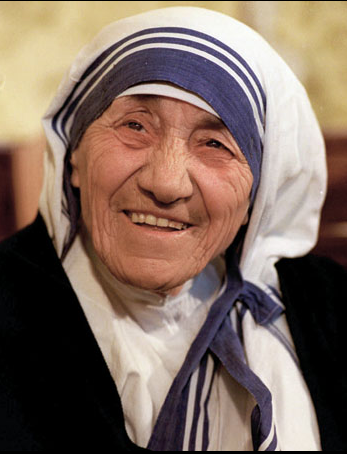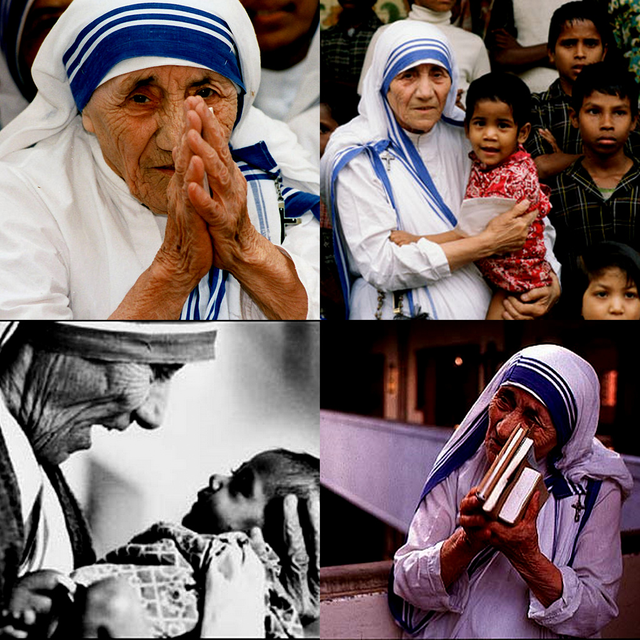
Mother Teresa was born Agnes Gonxha Bojaxhiu in Skopje, Macedonia, on August 26, 1910. Her family was of Albanian descent. At the age of twelve, she felt strongly the call of God. She knew she had to be a missionary to spread the love of Christ. At the age of eighteen she left her parental home in Skopje and joined the Sisters of Loreto, an Irish community of nuns with missions in India. After a few months' training in Dublin she was sent to India, where on May 24, 1931, she took her initial vows as a nun. From 1931 to 1948 Mother Teresa taught at St. Mary's High School in Calcutta, but the suffering and poverty she glimpsed outside the convent walls made such a deep impression on her that in 1948 she received permission from her superiors to leave the convent school and devote herself to working among the poorest of the poor in the slums of Calcutta. Although she had no funds, she depended on Divine Providence, and started an open-air school for slum children. Soon she was joined by voluntary helpers, and financial support was also forthcoming. This made it possible for her to extend the scope of her work.
On October 7, 1950, Mother Teresa received permission from the Holy See to start her own order, "The Missionaries of Charity", whose primary task was to love and care for those persons nobody was prepared to look after. In 1965 the Society became an International Religious Family by a decree of Pope Paul VI.
Today the order comprises Active and Contemplative branches of Sisters and Brothers in many countries. In 1963 both the Contemplative branch of the Sisters and the Active branch of the Brothers was founded. In 1979 the Contemplative branch of the Brothers was added, and in 1984 the Priest branch was established.

The Society of Missionaries has spread all over the world, including the former Soviet Union and Eastern European countries. They provide effective help to the poorest of the poor in a number of countries in Asia, Africa, and Latin America, and they undertake relief work in the wake of natural catastrophes such as floods, epidemics, and famine, and for refugees. The order also has houses in North America, Europe and Australia, where they take care of the shut-ins, alcoholics, homeless, and AIDS sufferers.
The Missionaries of Charity throughout the world are aided and assisted by Co-Workers who became an official International Association on March 29, 1969. By the 1990s there were over one million Co-Workers in more than 40 countries. Along with the Co-Workers, the lay Missionaries of Charity try to follow Mother Teresa's spirit and charism in their families.
Mother Teresa's work has been recognised and acclaimed throughout the world and she has received a number of awards and distinctions, including the Pope John XXIII Peace Prize (1971) and the Nehru Prize for her promotion of international peace and understanding (1972). She also received the Balzan Prize (1979) and the Templeton and Magsaysay awards.
Mother Teresa died on September 5, 1997.
great information dear thanks
Downvoting a post can decrease pending rewards and make it less visible. Common reasons:
Submit
I know she was a fraud. She wasn't a Christian. She was Catholic. She believed in a false gospel. She didn't believe in sharing the gospel with the dying. She didn't even believe in providing adequate medical care for those who weren't dying. She didn't believe in providing pain killers for terminal patients in severe pain because she believed in the redemptive power of suffering. They also don't know what she did with all the money she got in donations.
https://medium.com/@KittyWenham/mother-teresas-sainthood-is-a-fraud-just-like-she-was-eb395177572
Even when it came to her work with the children she is so well known for ‘supporting’, her aid was so dangerously lacking it bordered on negligent. Her Christianity harboured an obsession with suffering and death that influenced her care more than her desire to help ever would. She saw the struggle of those in poverty as admirable, she envied it, she thought it brought them closer to God. She likened their suffering to Christ on the cross and, in the worst years, she encouraged and condoned it; even within her ‘hospitals’ and ‘orphanages’. This abuse was especially rife in India, where she had risen to fame. Qualified doctors who visited her institutions were appalled at their conditions. Medical care was administered by volunteers with no medical training, hygiene was substandard, needles were reused until they became blunt, pain management was non-existent and staff were not able to make distinctions between those who were dying, and those who had curable illnesses.
In the 1950s, Mother Teresa helped found a ‘home for the dying’, where “people who lived like animals” could come to “die like angels”. She told those in pain that they were being “kissed by Jesus”, yet on her own deathbed was happy to accept the very best medical care on offer to her. One reporter who went undercover in one of her Kolkata homes described the conditions as “squalid” with nothing on the walls but pictures of their “mother” and attendants that laughed at children who had soiled themselves after being tied to beds all day. There was no dignity in the supposed care of these white-robed nuns.
The Church made sure there were plenty of pictures of her holding these children, though. She claimed that God had told her to help the poor whilst living amongst them, but in the peak of her career she spent very little time in Kolkata — the city she has become so synonymous with. She was jetted off to country after country; one day rallying against divorce laws in Ireland, the next being photographed with victims of natural and industrial disasters; none of which saw any share of the millions of pounds of funding her charity was receiving at the time. Mother Teresa claimed her mission was wholly apolitical, but on reaching the heights of fame, she spent most of her time directly intervening in political affairs across the globe.
She spent very little time with the masses, instead preferring the company of India’s rich and influential. This much is acknowledged, even by her own spiritual minister.
To this day, money continues to be an issue with the ‘Missionaries of Charity’ that Mother Teresa established in 1950. They refused to publish their accounts in India, where it is required by law. When asked to do the same in Germany, they responded that it was “none of their business”. A former sister put the annual figures of the organisation’s income at around $50 million in New York alone, but there is little evidence of any expenditures. Locally, services largely rely on donations and the appalling state of care in Mother Teresa’s time makes it clear that very little money makes it back to those they are helping, and new missions set up across the world are expected to become self-sufficient. Her charity received money from known-fraudsters, and when they were convicted in a criminal court, she tried to use her large personal influence to change the outcome of the trial. Sources suggest that the majority of money she received was sent straight to the Vatican bank; an institution few will believe in more dire need of assistance than India’s most vulnerable citizens.
Downvoting a post can decrease pending rewards and make it less visible. Common reasons:
Submit
Hi! I am a robot. I just upvoted you! I found similar content that readers might be interested in:
https://www.nobelprize.org/nobel_prizes/peace/laureates/1979/teresa-bio.html
Downvoting a post can decrease pending rewards and make it less visible. Common reasons:
Submit